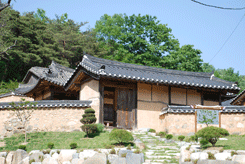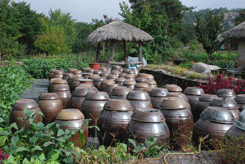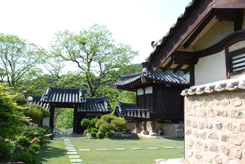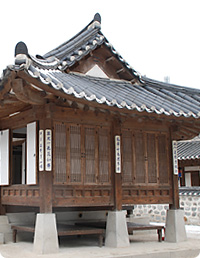Hanok
 |
 |
 |
Hanok
Hanok is the traditional Korean housing. Usually, the gate of a Hanok was found at the end of a narrow winding lane. Behind the gate, there was a yard surrounded by a stable and a Haengnang, servants' room or a yard with a room where the head of the household resided. Moving from the yard inside, there was another entrance called Jungmun, the inner gate. Deep within the inner gate, there were the Anchae, the inner quarters of the house in which the women lived and worked. In earlier days, a common type of Korean house was built primarily of wood and clay. The roof was not high and was thatched with straw or, for the more well-to-do, roof-tiles. The simplest form of the typical Korean house consisted of a living room, a sleeping room and a kitchen, with the toilet set apart and away from the living quarters. The structure and size differed according to the size of the family, the range of social acquaintances and wealth.
A larger house would consist of the main family quarters at the center, a closet, a maid's room, a barn and a toilet at the side. Toward the front part of the inner yard were quarters for the master of the house and for male guests, called "sarangchae," and adjoining the gate was a room for servants. Today, it would be difficult to point out a typical Korean house, for nearly all recent structures are of concrete or ferroconcrete construction. Though not widely recognized, this change, from predominantly wood structures to largely concrete structures, entails a subtle yet far-reaching transformation in the lifestyles of Koreans. Some of the rooms have ondol floors which are heated from under the clay floor. This system of heating is so ingrained in Korean life that even the most fashionable, Western-style houses built in recent years are, with few exceptions, provided with a few rooms that are heated through the floor. Likewise, many Koreans still prefer to sit and sleep on cushions and thick mats on the floor. In a traditional Korean home, there is little furniture and seating is on the floor. Bedrooms and living rooms were not distinguished; a living room also functioned as a dining room. Anbang used by the women of the house was located at the back of the house and was used as a place for family gatherings. Not surprisingly, this room was also equipped with wardrobes, bedding and other domestic paraphernalia. The master of the house, by contrast, inhabited the front part (sarangchae) of the house which was also used as a reception room for guests.
Ondol
Ondol, found only in Korea, is a heating system to warm the floor itself. An Ondol system is composed of an Agungi (furnace), a Gorae (floor heater), Gudeuljang (stone slab), and a Gulttuk (chimney). Agungi is a place to make the fire in and is located outside the room. The Gorae is the flue through which move the heat and smoke generated by a fire in the Agungi. The Gudeuljang is a thin flat stone covering the Gorae and at the same time forming the floor to the room. This lets the heat moving through the Gorae make the Gudeuljang hot, thus warming the floor. Finally, the Gulttuk, the chimney, is the passage through which the smoke, having moved through the Gorae, is eliminated outside the house.
Giwa
Korean tiles were used to build Yangban houses (upper class nobles). The tiled roof was characterized by the beauty of its curves. Seen from the front, the eaves of the roof had natural curves on both ends. Looked at from below, the center part curved inward and both the ends were turned outward. This line of beauty was applied to the ridges of the roof in the same way. Hanok varied according to the economic condition of the owner. The houses of the common people were simpler than those of the nobility, but they all used the same heating system. The structures and arrangement of rooms also varies by region.
Anbang
The Anbang, which literally means the inner room, was the main quarters for the head woman of the household. It is the room where she lived and worked. Because it was a woman's place, men, other than the husband and close relatives, were not allowed. For privacy, it was located in the very center farthest from the gate of the house. In general, the kitchen was attached to it. In the inner room, the husband and wife would sleep, eat their meals or occasionally receive visitors. Clothing and quilts were also kept in the room.
Sarangbang
It is the men's sitting room in a traditional Korean house. In commoners' housing, the Sarangbang was usually located across from the Anbang. However, in the homes of middle and upper classes, it was located in a separate building, Sarangchae. It has both a floored hall and a veranda. Outsiders were strictly forbidden to enter the building. Today, the Sarangbang is not as common in Korea. This is due to the fact that the roles of men and women are no longer so strictly differentiated in the home.
Daecheong
It is a wooden floored hall occupying the central part of the house and is connected on both sides with rooms. The function of this hall is for family gatherings, social meetings, receiving guests or dining. It is also a special place to gather all the family members for ceremonies is needed. In upper class houses, it is a symbolic of the family's consciousness of its status and authority, and it is used as an important space for wedding ceremonies or sacred rites. The hall is often decorated with potteries or antique pieces that are placed on the small tables.
Andaecheong
This wooden floor hall consists of the Anbang and Geonneonbang, the domain of the head women of the household and daughter-in-laws. The hall is furnished with a wooden rice chest, cupboards, ceremonial service sets, such as tables, chairs or candlesticks
Setdam and Jungmun (a small wall and inner gate)
The traditional Yangban residence was divided into inner and outer quarters that were used by women and men. A small wall was built on a large courtyard to separate living quarters. The access was made through Jungmun.
Kitchen
Kitchen was either attached to the Anbang, the women's living space, or built separately. Kitchen floor is generally slightly lower than other rooms so that smoke heats Ondol floors.
Gate
There are different gates of the houses. Soseuldaemun is a large main gate with a high upper roof. It indicated the social class of the house owner and served as a symbol of upper class homes. Jungmun is a small inner gate. The traditional high class people (Yangban) residence was divided into the inner quarters used by women and the outer quarters used by men. The sections were divided by erecting small walls in a large courtyard or using separate living quarters, and people accessed the outer sections through Jungmun.
Jangdokdae
This is a terrace where small and large crockery and clay ware were placed to store and ferment various foods. The Jangdokdae was situated in a clean area near the kitchen. This placement was chosen because it could get plenty of sunshine and ventilation to preserve food and maintain freshness.






